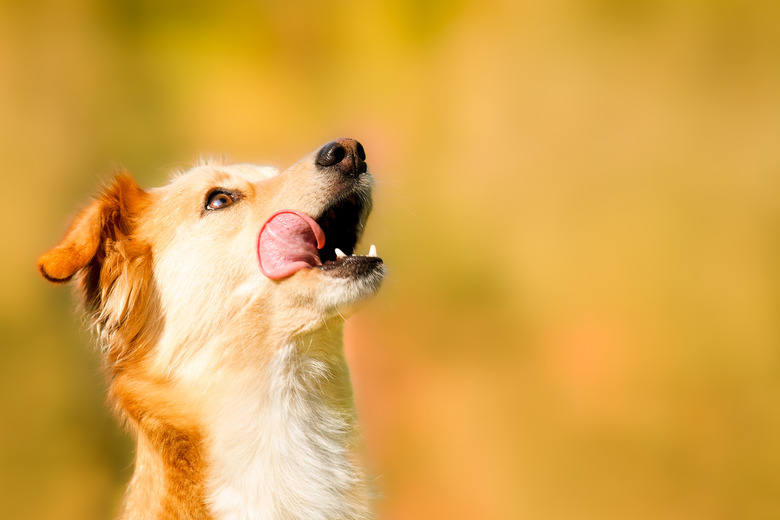Keeping Dogs Safe On Halloween
Celebrating holidays with dogs can lead to Instagram-worthy pictures and shared fun. A few simple steps can help to ensure that this Halloween is all treats, no tricks.
Prepare your dog a month before Halloween
Prepare your dog a month before Halloween
You can never predict what Halloween costumes trick or treaters at your front door might be wearing, but capes, hats, masks, and accessories can all scare a dog who is unused to seeing humans transfigured. The easiest way to make sure your dog doesn't spend the night shaking in a corner — or barking at your guest — is to start introducing these elements slowly. Do this well in advance of the ghosts and ghouls.
Start with hats. Even a baseball cap or sunhat can be unsettling for puppies or skittish dogs. When your dog is calm and in a place they feel safe, put a hat on and interact with them while wearing the hat. Pet them, toss a ball and play together to get them used to something new in their environment.
Some dogs will be completely unphased by the hat. You can try adding a mask, a bulky coat, a walker, or a cane. A dog might be startled by strange movements, like limping or zombie-walk. Your goal for this desensitization period is to introduce them to as many Halloween costume aspects as possible.
Remember: Halloween costumes can include anything you're putting on your dog. Any capes, manes, bandanas, or hats you want your dog to wear should also be introduced about a month before Halloween.
Check your dog's microchip and Id status a week before Halloween
Check your dog's microchip and Id status a week before Halloween
This is a good time to check your dog's microchip. You can visit your veterinarian's office, animal shelter, or animal control to have them scan your dog's microchip and make sure the information is up to date. The ASPCA advocates for a combination of visible tags on a dog's collar and a microchip ID tag with proper identification.
Adopted dogs may have been originally registered to the rescue that originally microchipped them. With this in mind, it is important to make sure your microchip ID tag has proper identification so it traces your dog back to you.
Keep your dog indoors the day before Halloween
Keep your dog indoors the day before Halloween
Now is the time to do a walkthrough of your house. Check that all of your Halloween decorations are dog friendly. Jack-o-lanterns and lit candles can be fire hazards around swinging tails. Consider using an LED tea light in place of a flame. Avoid glowsticks as well — they can be filled with toxic chemicals.
Electrical cords can be tripping hazards and easily pulled out by excited dogs. Tape any cords to the walls or floors — to make sure that paws don't get caught.
The day before Halloween is a popular night for pranksters. Also known as Mischief Night or Devil's Night, it's a time for teens to Toilet paper houses and causes general mayhem. It's best to keep dogs indoors and away from the path of the pranksters during this night.
Halloween safety tips for dogs
Halloween safety tips for dogs
You are well on your way to a dog-safe Halloween night. By now, your dog should be microchipped, used to Halloween costumes. You should have them in a dog-safe, flame-free environment. All that's left is the candy.
Xylitol sweetener is often used in sugar-free candies. Though this sugar alcohol is safe for humans, even a tiny amount is extremely toxic to dogs. Ingesting any amount of xylitol sweetener can cause low blood sugar, seizures, liver failure, or even death for dogs. Keep all Halloween candy, (particularly sugar-free candies that include xylitol sweetener and chocolate) in a closed container and well out of the reach of your dog.
When the night ends and you're eating the last of your Halloween candy stock, keep a trash bag close by. Candy wrappers are choking hazards that smell delicious to dogs.
In summary
In summary
Preparing for a dog-safe Halloween night can begin up to a month in advance. Get your dog used to Halloween costumes on humans and themselves. Make sure your microchip ID tag has proper identification by checking in with your local vet or animal shelter. Pranksters, glowsticks, jack-o-lanterns, and lit candles all present hazards in the days leading up to Halloween. But using some basic precautions can keep your dog safe on Halloween night. Finally, keep track of all candy wrappers and other choking hazards — and beware of sugar-free candies and chocolate. By thinking ahead and preparing in steps, you'll be able to enjoy the holiday with your dog. Happy Halloween!


